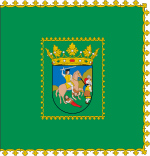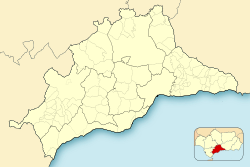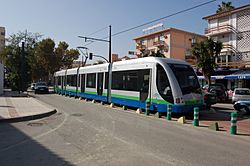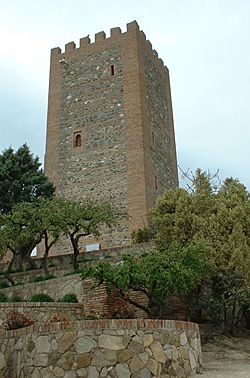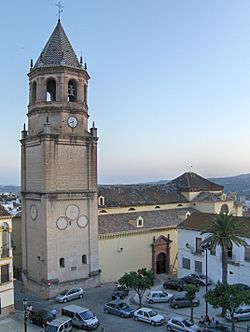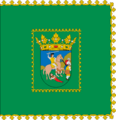Vélez-Málaga facts for kids
Quick facts for kids
Vélez-Málaga
|
|||
|---|---|---|---|

Collage of Velez-Malaga. Top left:San Juan Bautista Church, Top middle:View of Vélez-Málaga Fortress, from Remedios Hill, Top right:View of Los Remedios Hermitage、from San Cristbal Hills, Bottom left:View of downtown Vélez-Málaga, from Ermita Remedious Hill, Bottom middle:Vélez-Málaga tramway, near Torre del Mar Beach, Bottom right:View of Vivar Tellez Avenue from San Cristbal Hills
|
|||
|
|||
| Sovereign state | |||
| Autonomous community | |||
| Province | |||
| Comarca | Axarquía | ||
| Area | |||
| • Total | 157.88 km2 (60.96 sq mi) | ||
| Elevation | 60 m (200 ft) | ||
| Population
(2018)
|
|||
| • Total | 80,817 | ||
| • Density | 511.889/km2 (1,325.79/sq mi) | ||
| Time zone | UTC+1 (CET) | ||
| • Summer (DST) | UTC+2 (CEST) | ||
Vélez-Málaga is a city and the main town of the Axarquía area in the province of Málaga, Spain. It is part of the Costa del Sol region. People often just call it Vélez. This city is an important market town for local farmers. Unlike many coastal towns, it is not mostly about tourism.
Contents
Population and People
In 2015, Vélez-Málaga had about 78,166 people living there. By 2010, it became the fourth largest city in its province. Many people have moved here from other parts of La Axarquía. There is also a large community of Romani people. They mainly live in areas like La Villa and La Gloria.
In 2008, about 8,923 people living here were from other countries. The biggest group was from Romania. There are also smaller groups from China, Morocco, and other parts of Africa. Many people from Europe, especially Germany and the UK, also live here.
The main part of the city is Vélez-Málaga itself. It is a few kilometers inland from the coast. Other important towns nearby are Torre del Mar and Caleta de Velez. These three towns are very close and are growing together. They are connected by a main road and a seaside path.
Along the coast, you can find smaller towns like Almayate and Benajarafe. Inland, there are places like Trapiche and Triana. All these towns together form the larger Vélez-Málaga area. This wider area has about 92,928 people.
| Municipality | Population |
|---|---|
| Vélez Málaga | 78,166 |
| Algarrobo | 6,016 |
| Benamocarra | 3,047 |
| La Viñuela | 2,013 |
| Benamargosa | 1,568 |
| Arenas | 1.219 |
| Iznate | 899 |
| Total | 92.928 |
History of Vélez-Málaga
Vélez-Málaga has a long and interesting history.
Ancient Times
People lived in Vélez-Málaga even in the Iron Age. The first clear records are from the Phoenicians. They settled on the coast around 800 BC. They built ports and traded goods. They also worked with iron. The Romans later took over. They made salted fish and a special sauce called garum. Fishing and farming also grew during this time.
Middle Ages
The city of Vélez-Málaga grew a lot during the time of the Moors. Its name comes from old Moorish words. The city had a strong fortress on the highest hill. This fortress was important for defense.
Between the 13th and 15th centuries, Vélez-Málaga was a very important city in the Nasrid Kingdom of Granada. The city grew so much that people started living outside the main walls. Many small farms also grew around the city.
In 1487, King Ferdinand the Catholic took over Vélez-Málaga. The Muslim people were asked to leave the city. However, some villagers were allowed to stay. This was because the new rulers needed their farming skills.
Modern Age
After the Christians took over, the city changed a lot. New public squares and buildings were built. Old mosques were turned into churches. For example, the churches of Santa María and San Juan were built. Many monasteries were also built, making it a "convent town."
Vélez-Málaga became the main center of the Axarquía region. This is still true today. The area grew many grapevines and citrus fruits. These were sold and sent to northern Europe. Other lands were used for growing grains and sugar cane.
In the 17th century, the population went down because of diseases and wars. Pirates from Turkey and North Africa often attacked the coast. Watchtowers were built to warn the city. Vélez-Málaga supported the Bourbons during the War of Spanish Succession. A huge naval battle, the Battle of Vélez-Málaga, happened off its coast in 1704. Over 146 ships and 46,000 men fought.
Recent History
The 19th century started with a terrible yellow fever outbreak. More than 60% of the people died in 1804. Later, there were other diseases and dry periods. A strong earthquake in 1884 also caused a lot of damage. Many houses fell down, and people were hurt. The city slowly recovered by growing more sugar cane.
At the start of the 20th century, a railway came to Vélez-Málaga. It connected the city to the provincial capital. During the Spanish Civil War, the city faced many hardships. From the 1960s, tourism grew a lot. This changed Torre del Mar with many new apartment buildings.
Main Sights and Places to Visit
Vélez-Málaga has many interesting places to see.
Historical Center
The old part of Vélez-Málaga is a declared historical-artistic area. It has two hills. One has the Vélez-Málaga Fortress. Here you can see the main tower and the Church of Santa María la Mayor. The other hill has the Ermita de los Remedios. The old neighborhoods like "La Villa" have white, cubic houses that fit the land. Outside the old walls, you can find beautiful palaces and churches. These buildings make the streets very picturesque.
Religious Buildings
- Church of Santa María la Mayor: This church was built on an old Arab mosque. Its bell tower used to be the mosque's minaret. Today, it is home to the city's Holy Week Museum.
- Church of San Juan Bautista: Built in 1487, this church also stands on a former mosque site. It has a mix of styles, including Mudejar and neoclassical.
- Church of San Francisco: This church was founded by the Catholic Monarchs. It has Mudejar and Renaissance styles.
- Convent of the Claras: This 17th-century convent has a beautiful Baroque and Rococo design.
- Convent of the Carmelites: Built in 1699, this Baroque-style convent has a unique entrance.
- Hermitages: You can visit the Hermitage of San Cristóbal (also called Los Remedios) from the 17th century. There is also the Hermitage of Nuestra Señora de la Cabeza.
- Votive Crosses: Two old crosses remain in the city: the Cross of the Lamb and the Cross of San Sebastián. They were built after the Christian conquest.
- Camarín de la Virgen de la Piedad: This 17th-century building shows the city's strong religious devotion.
- Kalachakra Stupa: In the town of Triana, you can find one of Spain's few stupas. It is a modern, 13-meter-tall Buddhist monument.
- Hermit Complex of Almayate: This site has cave dwellings carved into rock. It was once an old Mozarabic church from the 8th and 9th centuries.
Civil Buildings
- Beniel Palace: Built between 1610 and 1616, this is a great example of 17th-century civil architecture. It now houses the María Zambrano Foundation.
- Casa Larios: This building, built in 1888, is now the Mayor's Office in Torre del Mar.
- Casa Cervantes: It is said that Miguel de Cervantes stayed here. The house has beautiful balconies and an inner courtyard.
- Former Hospital of San Juan de Dios: Built in 1680, this building was used as a hospital and later a home for the elderly.
- Villa Mercedes: A grand house from the late 19th century in Torre del Mar.
- Antiguo Pósito: This 18th-century building had two floors. One was for storing grain, and the other was a fish market.
- Nautical Club of Torre del Mar: A modern building from 1967, known for its curved shapes and white terraces.
- Fountains: Two notable fountains are the Fernando VI fountain and the Plaza de las Glorias fountain.
- Old Train Station: An example of early 20th-century architecture. It shows the style of the time when the railway arrived.
Military Buildings
- Fortress of Vélez-Málaga: Also called the castle, it sits on a hill overlooking the old town. It was mostly destroyed during the French invasion. The main tower has been restored.
- Walls of Vélez Málaga: Parts of the old city walls still stand. Two of the original four gates, Puerta Real and Puerta de Antequera, are also preserved.
- Castle of Torre del Mar: Only parts of the wall remain here.
- Casa Fuerte del Marqués: Also known as Castillo del Marqués, this 18th-century fortress in Valle-Niza was built for defense. It now houses a hotel school.
- Lookout Towers: Several old defensive towers remain along the coast. These include Torre Gorda in Benajarafe and the Tower of Chilches.
Transportation
A railway line was built from Vélez to Ventas de Zafarraya in 1922. However, it closed in 1960 because road transport became more popular.
A tram service used to connect Vélez to Torre del Mar. This tram made it easy to reach shops and restaurants. But due to money problems, the tram service stopped in 2012. Along the old tram line, you can find a hospital and a large shopping mall called El Ingenio.
The city's transport is growing. The bus station is getting bigger. Buses can take you through Torre del Mar, to María Zambrano, and even to the Málaga Airport. You can also find buses and trains to bigger cities in Spain from Vélez.
Vélez-Málaga has a small airport called Axarquía airport. It also has a fishing port. A main highway, the Autovía del Mediterráneo, crosses through the area.
Geography
The municipality of Vélez-Málaga has about 25 kilometers of coastline. The Vélez River is the most important river in the area.
Location and Nearby Towns
Vélez-Málaga is surrounded by several other towns:
- To the north: La Viñuela and Canillas de Aceituno
- To the northeast: Sedella and Arenas
- To the east: Algarrobo
- To the south: The Mediterranean Sea
- To the west: Rincón de la Victoria, Macharaviaya, Benamocarra, and Iznate
- To the northwest: Almáchar and Benamargosa
The city also has a separate part called Lagos. It is bordered by Sayalonga, Torrox, the Mediterranean Sea, and Algarrobo.
Districts and Neighborhoods
The municipality includes several districts:
- Almayate
- Benajarafe
- Cajiz
- Caleta de Velez
- Chilches
- Lagos
- Mezquitilla
- Trapiche
- Triana
- Torre del Mar
- Valle-Niza
- Vélez Málaga
Within the city, there are also urban neighborhoods like:
- Barrio del Pilar
- La Villa
- Pueblo Nuevo de la Axarquía "Carabanchel"
- La Gloria
- Capuchinos
Culture and Festivals
The most important event each year is the Royal San Miguel festival. It takes place at the end of September and beginning of October. Other festivals include Veladilla el Carmen and Santiago (St James) and Santa Ana.
Holy Week (Semana Santa) is also a very important time in Vélez-Málaga. There are 19 different brotherhoods (cofradias). They hold processions with beautiful floats to remember the crucifixion and resurrection of Jesus. It is one of the most famous Holy Week celebrations in Andalusia.
The town has a lively Flamenco music scene. There is a local club called Peña Flamenca Niño de Vélez. Another group, Flamenco Abierto, organizes regular performances in the Axarquía region. Famous artists like Jorge Pardo, a jazz musician, have performed here.
Notable People from Vélez-Málaga
Many famous people come from Vélez-Málaga:
- María Zambrano: A well-known philosopher.
- Joaquin Lobato: A poet.
- Fernando Hierro: A famous footballer.
- Juan Breva: A Flamenco singer, known for creating the Malagueña style of flamenco.
- José Beltran Ortega: Another Flamenco singer, also known as 'Niño de Vélez'.
- Luis Santiago Amador: A Flamenco singer, also known as 'Gitanillo de Vélez'.
- Evaristo Guerra: A painter.
- Amparo Muñoz: Miss Spain 1973 and Miss Universe 1974, who also became an actress.
- Rocío Molina: A talented flamenco dancer.
Images for kids
See also
 In Spanish: Vélez-Málaga para niños
In Spanish: Vélez-Málaga para niños


